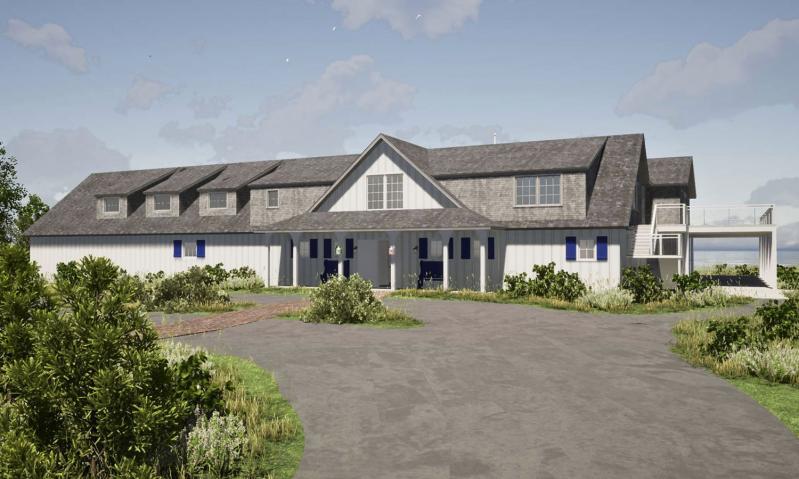Officially, it was a public hearing, but no one from the public spoke on the expansion plans for the Devon Yacht Club at last week’s East Hampton Town Zoning Board of Appeals meeting. Instead, Richard Warren of InterScience, the land use planner shepherding the application through the regulatory boards for Devon, and Lisa Liquori, a consultant to the Town Planning Department, offered competing visions of what the project means for the constrained and environmentally sensitive 13.2-acre parcel.
Devon requires 20 variances from the Z.B.A.: nine for wetland setbacks, eight for dune crest setbacks, and three for front yard setbacks along Abram’s Landing Road. The entire building envelope is in the natural resources special permit jurisdiction, meaning that no structure can be within 150 feet of a freshwater or tidal wetland.
Devon’s ambitious two-phase proposal for redeveloping the 108-year-old club involves demolishing five of its six buildings and rebuilding them larger and farther landward of Gardiner’s Bay. The hope is to start phase one of the work — the demolition and reconstruction of the clubhouse — in September 2026.
The planning board, which would need to give site plan approval, has reviewed the project for over two years before deciding that it could not move forward until knowing whether the Z.B.A. would approve the many variances required.
In an overview of the project, Mr. Warren characterized it as “mutually beneficial” to both the club and the town. The relief required, he admitted, was “daunting,” but said that it was no fault of Devon’s: “The difficulty was created by the imposition of regulations on this facility that has owned this property for 108 years.” The building project, he said, will not only bring the club into code compliance; it will make it more resilient to storm damage and rising sea levels; meet its minimum needs, improve the environment, and protect its “spirit and soul.”
Subtracting wetlands and beaches from the lot, he explained, yields just over six acres that are buildable. The site is further constrained because of the 150-foot setbacks from the dune along Gardiner’s Bay and from the wetlands on two other sides of the parcel. “There is no reasonable envelope on this property to reconstruct Devon Yacht Club,” he told the board.
But Devon is trying. The main clubhouse would grow by 60 percent, from its current 9,399 square feet to 15,051 square feet — over 5,000 feet larger than the largest allowed residence in the town. A new boat workshop is proposed. A bathhouse and sailing center, now housed together in one building, would instead be separated in two new ones. Staff housing would remain on site, but its square footage would double, due to the addition of a second story. (The Planning Department had wondered how much room could be added to the site if the staff housing were moved to another parcel.)
Four of eight existing tennis courts would be resurfaced. Parking, in accordance with a planning board suggestion, would nearly double, from 40 marked spots to 78, including four handicapped spots. Well over 5,000 cubic yards of fill would be imported so that septic and other structures could meet the minimum distance from groundwater.
Mr. Warren emphasized the environmental benefit of removing old septic systems and replacing them with new, low-nitrogen ones. A new stormwater drainage system will be installed as well.
He also assured the zoning board that the club would not expand its membership past 400, and highlighted club members’ support of East Hampton Town services. “They don’t just think about themselves, but also community,” he said. “It’s a quiet little
club nestled along the shoreline of Gardiner’s Bay, in the woods.”
The project is expected to cost some $20 million, all of it to be paid by its members. But, said Mr. Warren, “If you carve up this plan where they don’t get the benefit of the $20 million they’re going to spend, they won’t support it.”
Ms. Liquori spoke next. “The wetland complex traversing the property has been identified as one of the most magnificent in all of the town, with high plant diversity, critical flood resiliency, and water quality benefit,” she said. Speaking of Devon’s 760 linear feet of coastline along Gardiner’s Bay, she said she could not help pointing out that “a longtime feature of this landscape has been the intensely developed Devon Yacht Club itself.”
There are certainly some positive environmental aspects of the application, Ms. Liquori said, though counterbalanced by the difficult-to-ignore facts that seven buildings would meet fewer than half of the minimum wetland setbacks, and that staff housing would be only 12 feet from wetlands. She also questioned whether a proposed regrading of a dune was necessary.
The Z.B.A., she said, would have to determine whether the environmental improvements were enough to offset nearly 6,000 square feet of new development in the sensitive dune crest setback area.
“I’m not sure I see a path without eliminating things,” said Ed Johann, a board member. “We can say it should be farther from the wetland, but then we crash into something else.”
Roy Dalene, the board chairman, was concerned about many aspects, including drainage, grading, maximizing setbacks, and the visual impact of the project.
Jaine Mehring, a board member, had recused herself from the application. The four remaining members decided they needed to process what they’d learned and hold another hearing, on Dec. 17, before providing the planning board with written comments.




